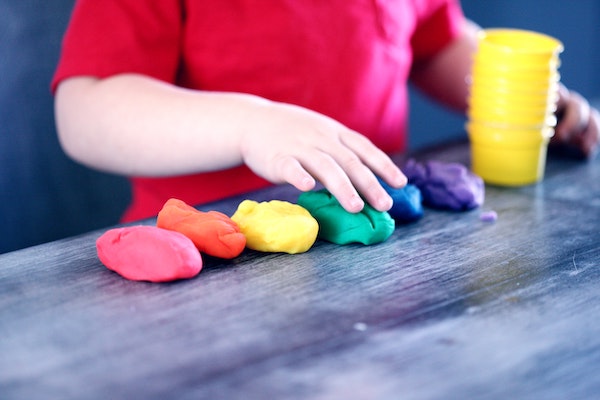
 Obsessive-compulsive disorder (OCD) is a neurobiological illness, and is listed in the DSM-5 (Diagnostic and Statistical Manual of Mental Disorders, 5th Edition) as an anxiety disorder. It is characterized by excessive, intrusive thoughts (obsessions) that lead to repetitive behaviors (compulsions). While the exact cause of OCD remains unknown, certain research findings have indicated that a child diagnosed with OCD does not produce sufficient amounts of serotonin, alluding that the development of OCD may originate within one’s brain. The Obsessive Compulsive Foundation of Metropolitan Chicago asserts that OCD appears to be “at least partially genetic and, in some cases, may be activated by a strep infection.” For children that are genetically predisposed, the onset of OCD can occur as young as three years old. It is more common, however, for OCD symptoms to begin in children around age ten. While there are several overlaps, the signs and symptoms of OCD manifest and are exhibited differently in children than in adults. OCD affects the way a child is able to adequately filter and process information. This, in turn, leads the child to perseverate on thoughts that would be otherwise ignored or dismissed by a child without OCD.
Obsessive-compulsive disorder (OCD) is a neurobiological illness, and is listed in the DSM-5 (Diagnostic and Statistical Manual of Mental Disorders, 5th Edition) as an anxiety disorder. It is characterized by excessive, intrusive thoughts (obsessions) that lead to repetitive behaviors (compulsions). While the exact cause of OCD remains unknown, certain research findings have indicated that a child diagnosed with OCD does not produce sufficient amounts of serotonin, alluding that the development of OCD may originate within one’s brain. The Obsessive Compulsive Foundation of Metropolitan Chicago asserts that OCD appears to be “at least partially genetic and, in some cases, may be activated by a strep infection.” For children that are genetically predisposed, the onset of OCD can occur as young as three years old. It is more common, however, for OCD symptoms to begin in children around age ten. While there are several overlaps, the signs and symptoms of OCD manifest and are exhibited differently in children than in adults. OCD affects the way a child is able to adequately filter and process information. This, in turn, leads the child to perseverate on thoughts that would be otherwise ignored or dismissed by a child without OCD.
Signs and Symptoms
Adolescence is a challenging time in one’s life. It is a time of significant physical, emotional, educational and developmental growth. It is not uncommon for a child to exhibit a plethora of varying behaviors prior to and throughout his or her adolescence. The signs and symptoms that a child with OCD may present might appear similar to the neurotypical child, but for a child with OCD they will be debilitating. The International OCD Foundation provide the following examples of commonly reported obsessions and compulsions displayed by children with OCD:
- Obsessions:
- Religious fixations
- Aggressive thoughts
- Fear of contamination
- A need for order, symmetry and/ or precision
- Sexual thoughts
- Fear of germs and/ or dirt
- Preoccupation with bodily waste
- Intrusive sounds and/ or words
- Preoccupation with household items
- Fear of illness and/ or harm coming to oneself and/ or others
- Compulsions:
- Repeating rituals (i.e. entering and exiting doorways multiple times)
- Ordering and/ or arranging objects
- Grooming rituals (i.e. showering, brushing teeth, hand washing, hair combing…etc.)
- Counting rituals
- Checking rituals (i.e. pushing repeatedly on doors to assure they are closed)
- Touching rituals
- Cleaning rituals (i.e. household items)
- Hoarding
- Rituals to prevent self-harm and/ or harming others
It is important to note that stress does not cause OCD, however it can exacerbate one’s symptoms. It is common for a child to attempt to hide his or her symptoms due to confusion and/ or embarrassment, depending on his or her age.
PANDAS
Children are highly susceptible to contracting typical illnesses (i.e. strep, the flu, the common cold, conjunctivitis…etc.). Some studies have found that a strep infection may trigger the onset of OCD symptoms in children. When this occurs, it is known as Pediatric Autoimmune Neuropsychiatric Disorder Associated with Streptococcal infections (PANDAS). The studies indicate that strep antibodies attack certain parts of a child’s brain, which can manifest as OCD symptoms. Although this is possible, it is imperative to bear in mind that the majority of strep infections in children do not lead to the development of any obsessions nor compulsions. Furthermore, most reported childhood OCD is unrelated to infection.
Treatment Options
The most effective method of treatment for children with OCD is formalized psychotherapy. There are a variety of different types of therapy that can be combined to create the ideal treatment plan for a child. Cognitive behavioral therapy (CBT) is most commonly used when treating children with OCD, according to the Child Mind Institute. CBT is multifaceted and a form of psychological treatment that is used by many mental health professionals. One of the specific types of CBT that is used in a child’s treatment plan is known as Exposure and Response Prevention (ERP) therapy. Through ERP therapy a child learns techniques to not only confront his or her obsessions but also actively commit to not engage in the compulsive behavior.
Depending on several contributing factors, supplementary treatment methods, such as medication, may be incorporated into a child’s treatment plan. Additionally, maintaining a healthy lifestyle by engaging in regular exercise, establishing healthy eating habits, and obtaining ample sleep can help reduce the severity and/ or frequency of a child’s OCD symptoms. With the proper treatment and support a child can learn to control his or her symptoms and implement healthy coping strategies for navigating and managing any subsequent recurrences.


 Nowadays there are a variety of different types of therapy available for individuals in need. While many therapeutic methods can be utilized concurrently, certain therapeutic techniques can be especially beneficial for certain ailments. Any qualified mental health professional will be able to assist in deciding the best course of action regarding one’s therapy plan. Having a broad understanding of the similarities and differences of some of the therapeutic modalities that are frequently utilized in mental health treatment can be helpful for a client. Certain therapeutic methods have tangential methods that are widely used. For example,
Nowadays there are a variety of different types of therapy available for individuals in need. While many therapeutic methods can be utilized concurrently, certain therapeutic techniques can be especially beneficial for certain ailments. Any qualified mental health professional will be able to assist in deciding the best course of action regarding one’s therapy plan. Having a broad understanding of the similarities and differences of some of the therapeutic modalities that are frequently utilized in mental health treatment can be helpful for a client. Certain therapeutic methods have tangential methods that are widely used. For example,